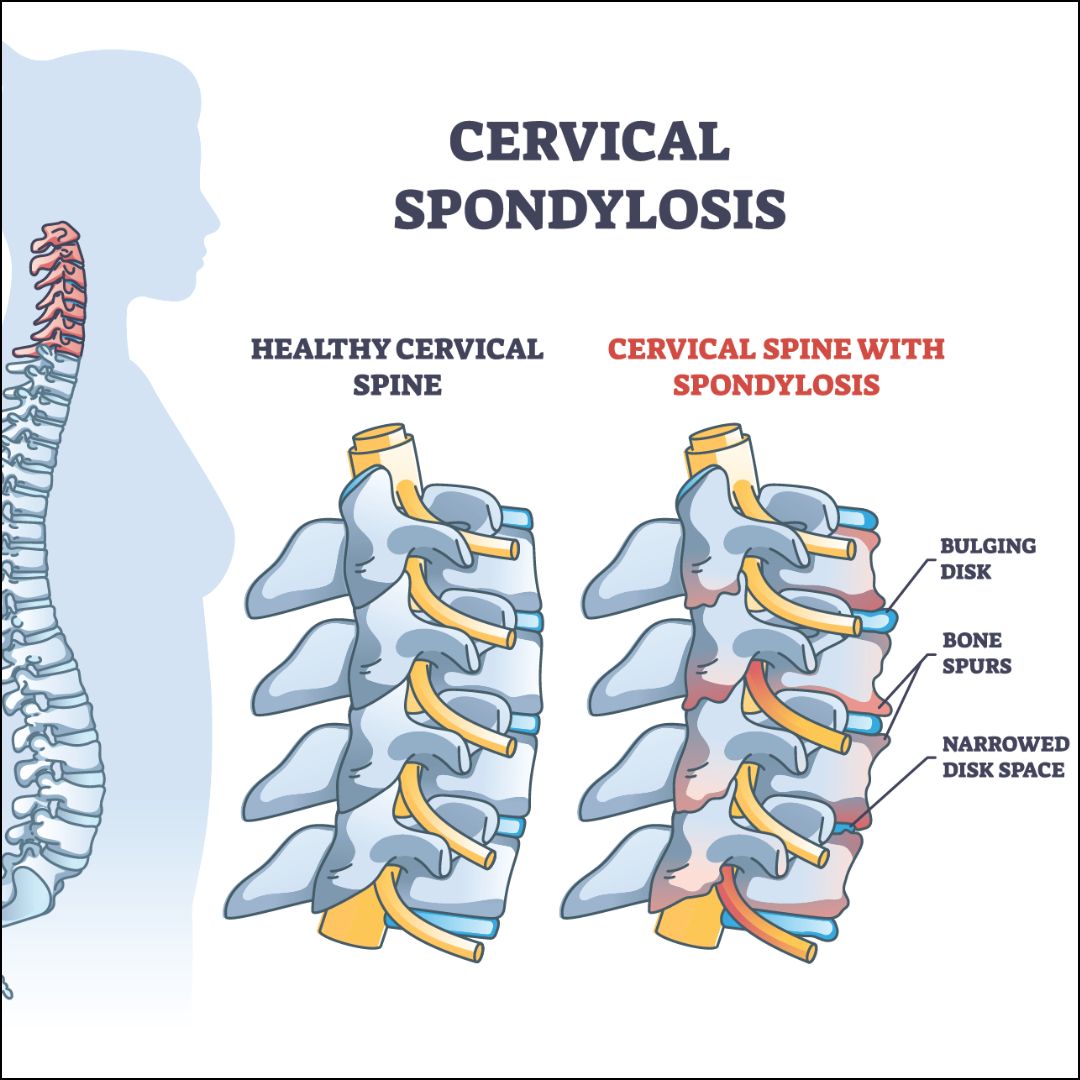
Cervical spondylosis, commonly known as arthritis of the neck, is a condition that affects the cervical spine due to age-related wear and tear. Over time, the discs and joints in the neck can degenerate, leading to pain, stiffness, and other symptoms. Although it is most common in people over 50, younger individuals can also develop cervical spondylosis due to lifestyle factors, genetics, or previous neck injuries. This guide provides insights into cervical spondylosis symptoms, treatment options, and preventive tips.
What is Cervical Spondylosis?
Keywords: cervical spondylosis symptoms, cervical spondylosis treatment
Cervical spondylosis occurs when the discs and cartilage between the vertebrae in the neck gradually deteriorate. As the body ages, spinal discs lose hydration and elasticity, causing friction between the vertebrae. This degeneration can lead to bone spurs, narrowing of the spinal canal, and compression of nearby nerves.
Symptoms of Cervical Spondylosis
Understanding the symptoms of cervical spondylosis can help in early diagnosis and treatment. Some of the most common symptoms include:
- Neck Pain and Stiffness
- Persistent neck pain and stiffness are the hallmark symptoms of cervical spondylosis. Pain may worsen with certain activities, such as looking down or tilting the head.
- Headaches
- Many individuals with cervical spondylosis experience headaches, especially at the back of the head, due to tension in the neck muscles.
- Pain Radiating to the Shoulders or Arms
- If nerve compression occurs, pain can radiate down to the shoulders, arms, and even hands. This is known as cervical radiculopathy.
- Numbness and Tingling
- Nerve compression from cervical spondylosis can lead to numbness, tingling, or a “pins and needles” sensation in the arms and hands.
- Muscle Weakness
- Weakness in the arms, hands, and even legs may develop in more severe cases, affecting one’s ability to grip or hold objects.
- Loss of Balance
- If cervical spondylosis compresses the spinal cord (cervical myelopathy), it can lead to issues with coordination and balance, resulting in difficulty walking or maintaining balance.
- Limited Range of Motion
- Stiffness and pain can reduce the neck’s range of motion, making it challenging to turn the head fully.
Causes and Risk Factors for Cervical Spondylosis
Cervical spondylosis is often age-related, but several factors can increase the risk:
- Age: Natural degeneration of the cervical spine becomes more prevalent with age.
- Lifestyle Habits: Poor posture, lack of exercise, and repetitive neck strain can hasten the development of cervical spondylosis.
- Previous Neck Injuries: Past injuries can weaken the neck and accelerate disc degeneration.
- Genetics: A family history of neck pain or spinal issues may predispose someone to cervical spondylosis.
- Occupation: Jobs that require repetitive neck movements or heavy lifting can increase the risk of developing cervical spondylosis.
Diagnosis of Cervical Spondylosis
Doctors typically diagnose cervical spondylosis through a combination of:
- Physical Exam: Checking neck mobility, muscle strength, reflexes, and sensation in the limbs.
- Imaging Tests: X-rays, MRI, or CT scans can reveal degenerative changes, bone spurs, or nerve compression.
- Nerve Conduction Studies: These tests evaluate nerve function to detect any nerve damage due to cervical spondylosis.
Treatment Options for Cervical Spondylosis
There are various treatment options to manage cervical spondylosis, ranging from conservative therapies to surgical interventions in severe cases.
1. Conservative Treatments
- Physical Therapy: Gentle exercises, stretching, and neck-strengthening exercises can improve mobility and reduce pain. Physical therapists can also recommend posture-improving practices.
- Medications: Over-the-counter pain relievers, such as ibuprofen or acetaminophen, can help reduce pain and inflammation. In some cases, doctors may prescribe muscle relaxants or stronger pain medication.
- Heat and Ice Therapy: Applying heat or cold packs to the neck can reduce inflammation and alleviate pain.
2. Lifestyle Modifications
- Posture Correction: Avoid prolonged periods of looking down or hunching over devices. Keep screens at eye level and use ergonomic chairs if sitting for extended periods.
- Regular Exercise: Engaging in regular physical activity helps strengthen the neck and back muscles, providing better support for the cervical spine.
- Avoid High-impact Activities: Activities that put stress on the neck, such as heavy lifting or intense sports, should be avoided or modified.
3. Alternative Therapies
- Chiropractic Care: In some cases, chiropractic adjustments can improve neck mobility and reduce discomfort, although they should be approached with caution, especially in severe cases.
- Acupuncture: Acupuncture has been shown to help relieve neck pain for some people, and may complement traditional treatments.
- Massage Therapy: Therapeutic massage can help reduce muscle tension, improve circulation, and relieve pain.
4. Injections and Surgery
- Steroid Injections: For severe pain, doctors may recommend corticosteroid injections to reduce inflammation around affected nerves.
- Surgery: Surgery is typically a last resort and may be considered in cases where there is significant nerve compression or spinal cord involvement. Surgical options include removing bone spurs, fusing vertebrae, or widening the spinal canal to relieve pressure on nerves.
Preventing Cervical Spondylosis
Preventing cervical spondylosis is not always possible, especially with age, but you can reduce your risk by adopting these preventive measures:
- Maintain Good Posture: Keep your head aligned with your spine and avoid hunching over devices.
- Stay Active: Regular physical activity and stretching can keep muscles strong and reduce stiffness.
- Strengthen Neck Muscles: Perform exercises that strengthen the neck and upper back to support the cervical spine.
- Take Regular Breaks: If you sit for long periods, take frequent breaks to stretch and move around.
- Use Proper Ergonomics: Set up your workstation so that your screen is at eye level, and use an ergonomic chair that supports your spine.
Final Thoughts
Cervical spondylosis is a common condition that can cause significant discomfort if left untreated. By recognizing the symptoms early and implementing preventive measures, you can effectively manage cervical spondylosis and improve your quality of life. If you experience persistent neck pain or other symptoms, consult a healthcare provider for an accurate diagnosis and personalized treatment plan.

